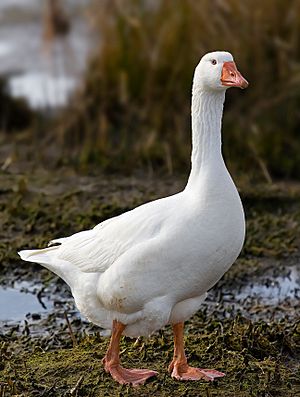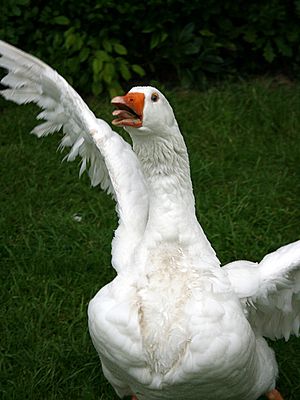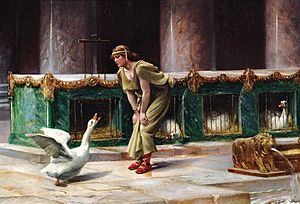Domestic goose facts for kids

Domestic geese are types of geese that humans have raised for a very long time. People keep them for their meat, eggs, and soft feathers called down feathers. These geese were first bred from two wild types: the greylag goose (found in Europe and Asia) and the swan goose (found in East Asia). Every year, about 700 million geese are raised and used for meat around the world.
Contents
Where Do Geese Come From?

In places like Europe, North Africa, and West Asia, the first domestic geese came from the greylag goose. In East Asia, they came from the swan goose. These are often called Chinese geese. Over time, both types of domestic geese have been brought to many other parts of the world, like Australia and North America. Today, you might find either type or even mixes (called hybrids) of them in flocks. You can easily tell Chinese geese apart because they have a large bump at the base of their beak.
People have been raising geese for a very long time. Charles Darwin, a famous scientist, noted how old goose domestication is. We have found proof of domestic geese in Egypt from over 4,000 years ago. Some experts think geese might have been first tamed around 3000 BCE in southeastern Europe, possibly in Greece. However, clearer proof of domestic geese comes from later, around the 8th century BCE, mentioned in an old story called The Odyssey.
Geese were also important in ancient Mesopotamia. People raised them for food and for special ceremonies. Pictures of geese appear in Mesopotamian art from as early as 2900–2350 BCE. By the time of the New Kingdom of Egypt (1552–1151 BCE) and in Europe, fully domestic geese were common. The Romans were very good at raising geese by the 1st century BCE, keeping many different kinds. During the Middle Ages, raising geese was very popular, with many farmers keeping large groups of them.
What Makes Domestic Geese Special?
Domestic geese have been specially bred to be much larger than their wild relatives. Some types can weigh up to 10 kg (22 lbs). Wild swan geese usually weigh up to 3.5 kg (7.7 lbs), and wild greylag geese up to 4.1 kg (9 lbs). This extra weight changes how they look. Wild geese stand more horizontally and have a slim back end. Domestic geese, however, store a lot of fat near their tail, making their rear end look bigger and causing them to stand more upright. Even with their heavy weight, most domestic geese can still fly.
Humans have also bred geese to lay many more eggs. A female domestic goose can lay up to 50 eggs a year, while a wild goose usually lays only 5 to 12.
It can be hard to tell male (ganders) and female (geese) domestic geese apart just by looking. Males are usually a bit taller and larger with longer necks. You can also tell them apart by their behavior. Male geese are very protective of their mates and young. A gander will often stand between his family and anything he sees as a danger.
The feathers of domestic geese can vary a lot. Many have been bred to be completely white or mostly white, losing the dark brown colors of wild geese. White geese are often preferred because they look cleaner after their feathers are removed. Some types, like the modern Toulouse goose, still look very similar to the wild greylag goose in their feather colors, but their body shape is different. White geese have been highly valued since Roman times.
Geese lay large, edible eggs that weigh about 120 to 170 grams (4.2 to 6 ounces). You can use them in cooking just like chicken eggs. Goose eggs have more yolk, and when cooked, the yolk is a bit denser. They taste similar to chicken eggs, but some people find them a bit richer.
Just like their wild ancestors, domestic geese are very protective of their young and other geese in their group. A gander will usually put himself between any danger and his family. Because they can be quite aggressive, make loud calls, and notice unusual movements easily, geese can be good for helping to guard a property. In the 1950s, in South Vietnam, the air force even used flocks of geese to guard their parked airplanes at night because of the noise they would make if intruders came near.
Domestic geese that came from the greylag goose are still the same species as their wild relatives. This means that if a domestic goose escapes, it can breed with wild geese. Their offspring might look like either parent or have a mix of grey and white feathers with orange beaks.
Geese in Stories and Myths
Geese appear in many old stories and myths. In ancient Greek myths, when the goddess Aphrodite first came to land, she was welcomed by the Charites (who were like goddesses of charm and beauty), and their chariot was pulled by geese.
You might know the "Mother Goose" tales, which are like stories a farmwife might have told. There's also the famous story of "The Goose that Laid the Golden Eggs", which teaches a lesson about being too greedy.
A famous Roman story tells how geese saved Rome around 390 BC. It's said that geese living in the temple of Juno on the Capitoline Hill made a lot of noise when the Gauls tried a surprise night attack. This noise woke up the Roman guards, who then defended the city. This story might have been created to explain why the Romans kept a special group of geese at Rome.
Images for kids
See also
 In Spanish: Ánsar para niños
In Spanish: Ánsar para niños











